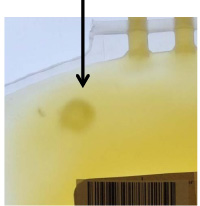Recognizing a Septic Transfusion Reaction
Case StudyCase Study:
Clinical Challenge in Recognizing a Delayed Septic Transfusion Reaction
Quality Improvement After Multiple Fatal Transfusion-Transmitted Bacterial Infections1

Contaminated platelet bag showing Staphlyococcus aureus.
- A neutropenic leukemia patient received routine outpatient platelet and RBC transfusions.
- Platelets and first RBC unit were transfused without incident, within minutes of starting the second RBC transfusion patient developed rigors, transfusion was stopped.
- Symptoms resolved temporarily, but two hours later was admitted for neutropenic fever.
- Given timeline and neutropenia, contamination of the platelet unit was not suspected, and the co-component platelet unit was not quarantined.
- The following morning, visual inspection of the co-component revealed “cotton ball”-like flocculation of Staphylococcus aureus, testing revealed a match to the infection in the patient.

Additional Resources

Download an educational poster on diagnosis of a septic transfusion reaction